It seems so simple to install and fix pipes in an efficient manner. But because the conditions and facilities for each project differ, it is always a new puzzle to solve. One system asks for plastic pipes and other needs copper or
 steel ones. Or perhaps even a combination of materials. Efficient installing and fixing of tubes obviously also depends on costs, therefore we advise you to take note of the following!
steel ones. Or perhaps even a combination of materials. Efficient installing and fixing of tubes obviously also depends on costs, therefore we advise you to take note of the following!
What are the rules to determine the distance between the brackets? There are no real guidelines or standards in the engineering sector (especially the W-branch). This means that you as an installer have a degree of freedom. A pitfall of this freedom is that the bracket distance is sometimes made too wide. This can mean, especially with plastic pipes, that the pipes start to bend. Something you do not want with a waste pipe.
An efficient way of installing is to combine different pipes, in diameter, material or even from another installation in one support/fixing. As a rule of thumb the pipes with the shortest bracket distance (by diameter or material) determine the distance used.
But what is the maximum bracket distance?

The pipe and tube manufacturers almost always give a maximum permissible bracket (fixing) distance. This distance is determined by the combination of the material of which the pipe is made of and on the diameter (larger diameter, stiffer tube) it concerns. There are many tables on the internet that illustrate this.
With steel pipes the bracket distance is permissible to 6 meters. In practice, you rarely see this. An exception to this rule are long straight sections, because it is not practical to hang up a 6 meter tube in one go. The handling by installers/technicians is in this case a bottleneck.
Another major point is that you have to calculate the weight of the 6 meter tube on the two brackets. This leads to heavy brackets and anchorages. In brief, it is very difficult to have the correct bracket distance shown in table form.
As an installer, you are ultimately responsible for determining the appropriate bracket distance. You can do this based on your own experience or through reading the manufacturer’s documentation. You can also contact Walraven and consult with our experts.
Together with our experts, you can determine the most efficient (and economical) way of installing and fixing. The way you work, in conjunction with the maximum extent permitted in terms of the materials to be used, are in this case leading.
We have the knowledge and experience to help you with your installation questions. Our experts calculate the ideal distance for your project. Please call us on tel:+37 061 651 341 for tailored advice.